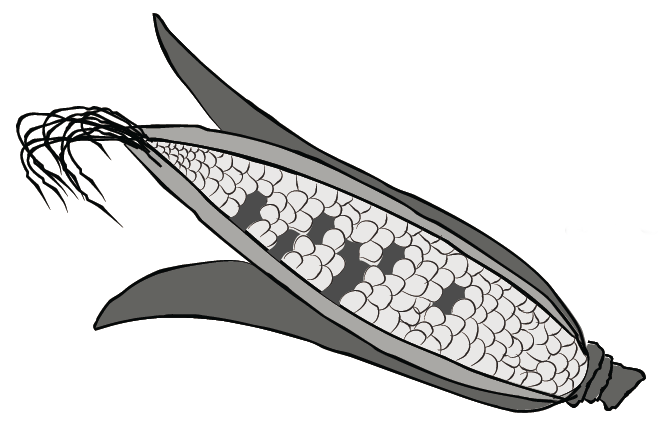Corn and Spinach Pollination

Bob Wildfong
Have you ever tried to grow a row of sweet corn in your garden only to be disappointed by poor results? I don't mean squirrels, raccoons, or insects eating your corn when it's almost ripe. I mean ears that are missing so many kernels they look like an old hockey player's teeth from the 70's.
The reason why kernels sometimes go missing from an ear of corn is that those kernels weren't pollinated. Imagine husking an ear of fresh sweet corn, ready to go in a pot of boiling water. You know those sticky threads that run inside? They're called silks, and there's one attached to each and every kernel. When corn pollinates in the field, a grain of pollen has to land on the end of each silk, and grow its way down to the kernel, which it will fertilize to make a seed. If a silk doesn't get a grain of pollen, then its kernel won't turn into a seed, and you'll see an empty spot where it should have been.
If you've been reading this newsletter you'll know that bees and other insects are crucial for pollinating most fruits and vegetables. But corn is different. Corn pollen is light and dusty, and it travels by wind instead of by bees. The tassels at the tops of the plants make pollen, and release enormous amounts of it into the air. The light grains of pollen float down to land on the leaves, the ground, the neighbouring field, and occasionally, on a corn silk. Whereas other plants have bees to deliver pollen directly to their flowers, corn has to rely on luck and lots of pollen in the air.
So here's the problem: if you sow your sweet corn in a single row in your garden, chances are the pollen will float away, or blow away, and hardly ever land on the ends of the silks further down the stalks. In fact, the pollen would have to fall straight down, or exactly in the direction of the row, to land where you need it. The result is lots of corn pollen laying on other parts of your garden, and not many kernels in your corn.
But here's the solution: instead of sowing sweet corn in a single row, sow it in several part-rows adjacent to each other. That forms a block of corn in the garden, so whichever way the pollen blows it will land on a neighbouring corn stalk. The chances of hitting a silk are much greater, so you'll get much better pollination, and fewer missing kernels.
Actually, all wind-pollinated plants act this way. Spinach, beets, and swiss chard are also wind pollinated, but the difference is you don't have to use the block planting trick to get a good harvest. That's because pollination is only necessary for making fruit and seeds, but most people grow spinach, beets, and chard just for the leaves and roots.
However, if you're saving spinach seed, or if you're planting last year's beets out for this years seeds (beets are biennials that take two growing seasons to produce seeds) it's good sense to plant them in a block instead of a straight row.

A romantic Bloomsdale spinach couple: she's on the left and he's on the right
Here's a tip everyone can use: when you harvest your spinach, leave a portion of the row in the garden and allow it to go to seed.
About half of the plants are male, and they have tiny yellowish flowers that just make pollen. The other half are female, and their stems grow dozens of green lumpy balls - which turn into brown seeds.
Once the seeds turn brown, strip them off and plant them right away. You'll get another planting of delicious spinach, for free, with enough seeds left to plant next year.
I haven't had to buy spinach seeds for years!
**
Bob Wildfong is Seeds of Diversity's executive director
Not yet a member?
An annual membership to Seeds of Diversity gives you access to our seed exchange, seed grow-out programs, and our online news.

We depend on donations to do our work.

Thank you for your support!
